CLIVE ROSS' RESEARCH
The
Aztec “Sun Stone”
It
was the beginning of the end…the year 1521 AD…Cortes
and his band of Spanish Conquestadores were passing judgement on their
captives the Mexicas (Aztecs) on the very soil where these indigenous peoples
had once walked in harmony with nature. The natives of this glorious land were
to become no more than a passing flicker in time and memory.
Over
two hundred and fifty years had passed since this unfortunate historical
event. Then, without warning, the torch of ancient Aztec history rekindled the
long forgotten pride once bestowed within the hearts and souls of these
courageous Mexican warriors.
Perhaps
by fate or design, whatever the cause, it was during the renovation of Mexico
City’s central plaza in 1790 that the most exciting addition to this
country’s historical past was uncovered…the Aztec “Sun Stone”.
Neither
photographs nor drawings can do justice to the marvel in craftsmanship
required to produce this single piece of carved basalt stone. Measuring 3.6
meters (12 feet) in diameter, this single stone weighs an estimated 24 tonnes
(Ill.1).
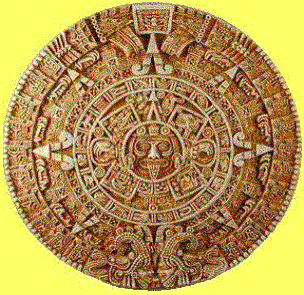
Illustration
1. The Aztec “Sun Stone” was discovered in 1790,
measuring 3.6 meters in diameter and weighing an estimated 24 tonnes.
An
additional two hundred years have passed and various theories for the unique
design are abundant. They are put forward in an attempt to uncover the reasons
for the mysterious intertwining geometric markings dispersed throughout the
stone.
The
most evident symbol is the face within the centre circle; it representing the
Sun (Tonatiuh), but it is the balance of these markings that have
stumped the finest of archaeologists.
Supported
by other written ancient documents, the inner circle of twenty small glyphs
have been successfully decoded and represent the twenty days to the month,
having thirteen months to a complete cycle; this was their “almanac year”
of 260 days. The second counting system was the “solar year”,
totalling 365 days and consisting of eighteen (18) months each having four
weeks of five days (20 days) per month…this totalled 360 days. By adding
five extra days, known as the nemontemi (empty days), it brought the
total count to 365 days…this is what we are taught !!!
Although
it may appear irrelevant to the Giza pyramid complex, the “Sun Stone” will
be one of several astronomical measuring systems chosen to guide us toward a
similar design used by the ancient Egyptian pyramid builders.
The
first step is to create a basic geometric duplication of the stone from the
photograph above (Ill. 2).
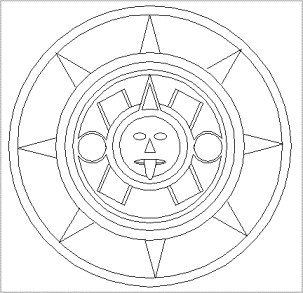
Illustration
2. The basic geometric design of the “Sun Stone”.
Note
the Sun’s face drawn in the centre, having two inner rings “earrings”
representing circular objects on opposite sides of the Sun’s face. Four
oddly positioned rectangles are also attached to the side of the face; two
above and two below the “earrings”. When combining these object we can
notice the similarity between them and the Aztec glyph Xihuitl
representing the solar year (Ill. 3). The similarity in formation could be a
construed as the inner portion of the stone’s design representing the solar
calendar of 365 days…as expressed by archaeologists.

Illustration
3. The glyph Xihuitl representing the solar year, most similar to the
centre design of the “Sun Stone”
Given
the centre face as the first indication to a solar reference, coupled with the
eight lines required to produce the glyph Xihuitl, and the eight
triangular points surrounding the outer ring of the stone, should be most
obvious to astronomers. These points indicate the ancient’s full knowledge
of planet motion around the Sun when using Earth’s annual measure of time!
Venus
and Earth share an intriguing orbital feature…Venus travels (1 + 5/8) of its
orbit for every orbit of Earth and this sets the stage for an astronomical and
geometrical feature between both planets…These two planets will realign with
each other every eight Earth years…IN THE SAME ORBITAL LOCATION WHERE THEY
STARTED FROM ! Venus and Earth are the only two planets in our solar system
having a realignment ratio equally divisible into a 360 degree circle, and the
ancient Aztecs were fully aware of this astronomical fact. To prove it, we
simply compare the basic geometric design from illustration 2 to the orbital
alignment locations for Venus and Earth as illustrated below (Ill. 4).
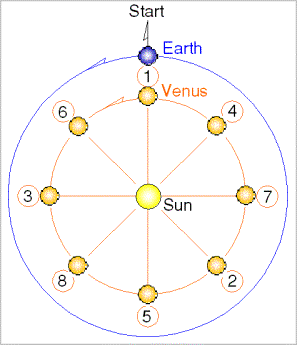
Illustration
4. Travelling in a counter clockwise direction, the eight locations for Venus
are shown for each complete and successive orbit of Earth around the Sun.
Starting
the cycle with Earth and Venus aligning with the Sun at position #1 (12
o’clock); Earth orbits the Sun once while Venus completes its first orbit
and continues to position #2. The second full orbit of Earth will place Venus
in position #3…continuing the count for eight Earth years. The end of the
eight year cycle brings both planets back to the original start position. From
the orbital diagram, we can now realize why the Sun Stone has two triangles
pointing toward the twelve o’clock position; one represents the location of
Earth and the other for Venus at their start location.
There
are two simple but important mathematical relationships between both planets
that should be remembered.
1)
Venus travels thirteen “parts” of its orbit for every eight “parts” of
orbit that Earth completes (13/8, or 1.625:1 ratio).
2)
Earth and Venus aligned in the same orbital location every 8 Earth years.
There
is one other significant feature that the designer(s) wanted to express and it
is demonstrated by the two “earrings” and the four rectangular forms
surrounding the face.
In
four complete orbits of Earth, Venus will travel six complete orbits around
the Sun then continue to a point exactly 180 degrees in orbit from the start
position. The four rectangles surrounding the face represent four Earth years,
and the two “earrings” represent the two locations for Venus set 180
degrees from each other.
The
“solar year” count within the Mayan calendar system totals 365 days, and
this confirms that the designer(s) knew the orbital ratios for Venus and
Earth.
We
may have actually assumed in the wrong direction…
Eight
counts of 365 Earth days is equal to thirteen complete orbits of Venus, and
Venus orbits the sun in 224.7 Earth days. Working in the reverse
direction…if the calendar was set by comparing the orbital period of Venus
to that of Earth then this measure would calculates to 224.62 Earth days for
one complete orbit of Venus, a 0.08 day error per orbit of Venus.
The
ancients knew the number of days to the Earth year most accurately, but
elected to use the full day count to register the location of the planet
Venus. However, there was one additional planet to be considered…our outer
neighbour Mars !!
Recalling
the second counting system…the “almanac year”; it is based on a
260 Earth day cycle and it is this count that ties both Earth and Mars
together in their respective orbits.
Mars
orbits the sun in 686.98 Earth days, compared to 365.256 days for Earth. The
time required between two consecutive alignments of two planets is termed the
synodic period. To calculate this value requires simple mathematics, and for
Earth and Mars the total time is 780 Earth days. It is at this point where we
stop and investigate another simple mathematical situation….3x260 days = 780
days.
…780
Earth days equals three complete “almanac years” !!
To
illustrate, we set Earth and Mars at the 12 o’clock location (Ill. 5,
position #1). Rotating counter clockwise for 260 Earth days, Earth and Mars
will travel to a location in orbit where they are 120 degrees apart from each
other (Ill. 5, position #2). The second count of 260 Earth days (Ill. 5,
position #3) shows Earth having completed one orbit and leading Mars by an
additional 120 degrees, totalling 240 degrees in orbit. After the third count
of 260 Earth days, both planets realigning at a point 48.71 degrees from the
start position (Ill. 5, position #4).
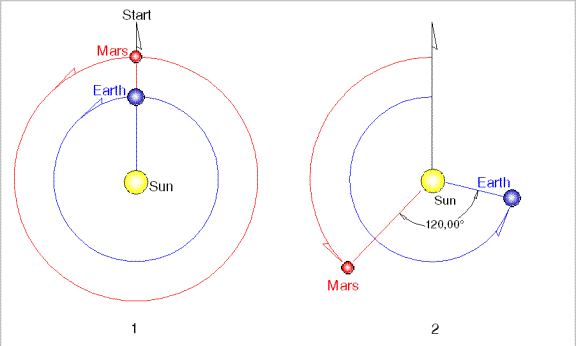
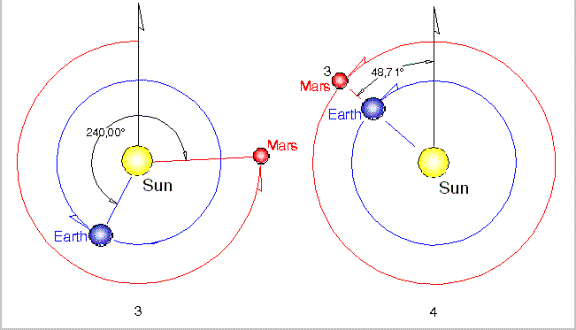
Illustration
5. The orbital locations for Earth and Mars at the end of each “almanac
year” of 260 days. Three “almanac years” equals one synodic
period for Earth and Mars.
The
three counts of 260 days indicates to us that the ancients understood the
orbital alignment of Earth and Mars. To confirm, they designed another
geometrical feature within the stone.
From
illustration 5, we can continue to plot the sequential orbital locations where
Earth and Mars will align until the 360 degree circle is complete (Ill. 6.)
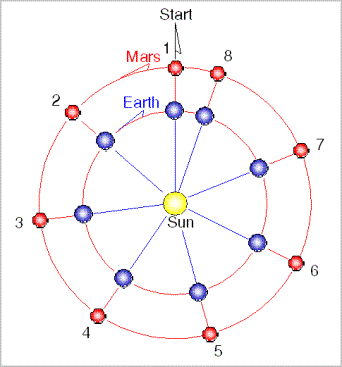
Illustration
6. The alignment locations for the planets Mars and Earth,
starting from the 12 o’clock position.
Compared
to the Venus/Earth pattern, it is noticed how the last alignment location
(position #8) falls short of the complete 360 degree circle. However, there is
the common element of eight locations within the 360 degree circle and it is
this pattern that the designer(s) emphasized. By rotating the start point to
geometrically “balance” the pattern we have a different view of the
alignment locations (Ill. 7).
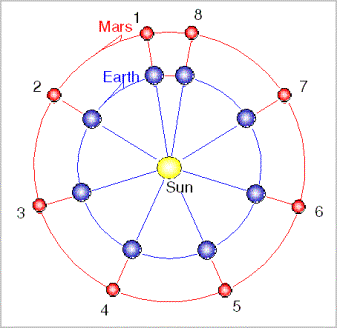
Illustration
7. The eight locations where Mars and Earth align are “balanced”
geometrically.
From
illustration 3, the glyph Xihuitl
is reintroduced and compared to the “balanced” pattern of the eight
locations where Earth and Mars align (Ill. 8).
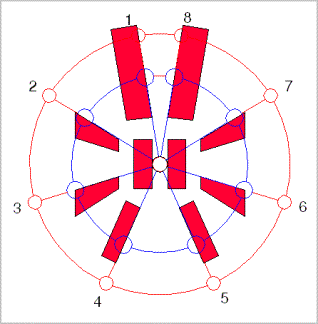
Illustration
8. The glyph Xihuitl, assumed to symbolize the solar year, is
superimposed over the eight alignment locations for Earth and Mars
Xihuitl
is
the symbol for the solar year and drawn geometrically identical to the eight
alignment locations for Earth and Mars. Were archaeologists lead astray with
the concept of this glyph representing a solar year? Is it possible that it
represents a synodic year of 780 days, this being equivalent to three almanac
years, or the interval between each realignment of Earth and Mars in the
heavens?
The
Sun Stone contains two simplified Earth calendar systems, each relating
directly to the planets Venus and Mars. Included within the design are the
orbital characteristics of these same three planets. What must be acknowledged
is the simple fact that the ancient Aztecs were most knowledgeable of planet
motion. It is unknown how or when the Aztecs may have gained such knowledge,
however it is most obvious they understood and comprehended the central solar
disc (Sun) and visualize the basic mathematical relationship between the
orbital paths for our two neighbouring planets: Venus and Mars when compared
to Earth.
The
Aztec “Sun Stone” is….astronomy carved in stone !!